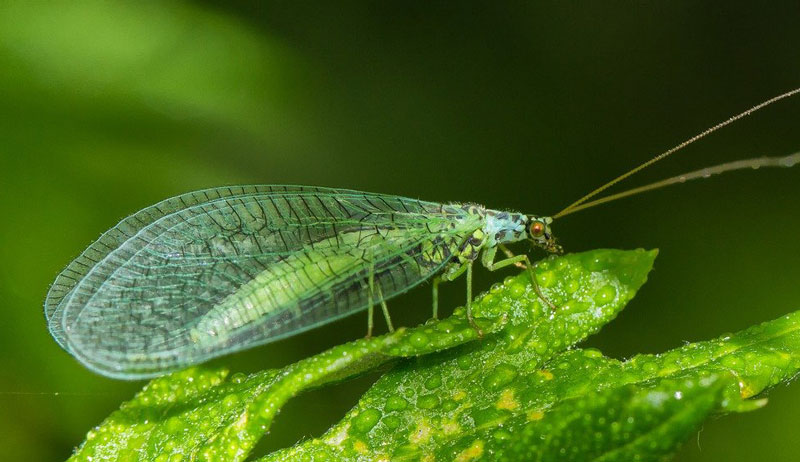
Spring is here! And if you’re like many gardeners, you’re eager to get out into your garden and start clearing out those dead leaves and plants and downed wood. Tidying up the garden is important for many reasons, and it’s so satisfying to finally get those seeds and starts in the ground.
But stay your hand. Beneficial insects are beginning to emerge, and they aren’t ready to give up their houses yet. Here is a short list of beneficial insects to look out for.
Praying Mantis/Mantids
These striking insects with their bowed legs, triangular heads and an unsettling way of turning their heads to look at you will eat anything, beneficial or not. They aren’t picky—whatever insect happens to wander into its territory, the Mantis will happily consume it.

The eggs overwinter in a misshapen sticky brown egg case, called an ootheca, that clings to branches or sticks. Look for them as you rake out your garden or prune your trees and bushes. They hatch out as tiny versions (up to 100 eggs) of their adult selves in shades of brown or green.
Note: Mantid egg cases can be found for sale in shops to release into your garden. Make sure the cases are native to your area and not the Chinese species, which will eat beneficial vertebrates like hummingbirds.
Read more: Check out these 7 common questions about the mighty mantis!
Damsel Bugs
These tiny, elegantly named bugs are actually fierce predators with spiked mouthparts and legs that can hang on to prey. They will snack on aphids, thrips, spider mites, insect eggs and caterpillars.
The pill-shaped, cream-colored eggs are found in plant tissue, which will then hatch into flightless nymphs before developing into adults. As eggs and adults, Damsel bugs overwinter in crop fields, pastures, long grasses near gardens, hiding under litter or mulch.
Damsel bugs are found in shades of golden, brown, grey or black.
When cleaning the edges of gardens, fields and other cropping areas in the fall, leave the debris until late spring for these beneficial insects.
Ladybug/Lady Beetle
Often the subject of nursery rhymes and picture books, the little round ladybug may appear ladylike. But she’s happy to devour as many aphids or scales as she can get her mandibles on.

According to the Xerces Society for Invertebrate Conservation’s Habitat Planning for Beneficial Insects: Guidelines for Conservation Biological Control (Jennifer Hopwood, Eric Lee-Mäder, Lora Morandin, et al), one ladybug can eat up to 5,000 aphids in her lifetime. The insects will also snack on open-faced flowers.
The ladybug’s yellow eggs are found grouped together on leaves and stems near prey habitat. Larvae resemble alligators, with tube shaped “scaled” bodies.
In the summer, adult lady bugs shelter in tall stands of grass. Groups of ladybugs overwinter in dead leaves, rock crevices and in roof eaves. Some species (particularly non-native species) overwinter inside houses.
They are brightly colored, in shades of beige to red to orange to black. Some are solid where others are polka-dotted or striped in black or reds.
After cutting ornamental grasses in the spring, stack the bunches near a wooded area near your mulch pile or untilled part of your garden. This allows ladybugs to get a head start.
Note: Not all ladybugs are beneficial insects. There are non-native species that were introduced to the U.S. for bug control. Now these interlopers, such as the seven-spotted and Asian lady beetles, are taking over native species.
Green & Brown Lacewings
The aptly named lacewing has delicate translucent wings. But the insect is anything but delicate. Its mouthparts are shaped for stabbing prey, and it can travel over 100 feet to hunt.

The cunning green lacewing will wear a costume of leaves, moss and other forest debris to camouflage itself from prey and predators. Lacewings live in orchards or in the fringes of wooded areas. They lay their rice-like eggs, which hang on long threads, on foliage near prey in order to provide nearby food for hatchlings.
Lacewings prefer soft-bodied prey and will also feed on pollen and nectar.
As you tidy your garden, look for lacewings overwintering in cocoons wrapped in silken threads stuck to leaves or adults in sheltered areas. You’ll find then in shades of green and brown.
Read more: Want more like this delivered to your inbox? Sign up for our newsletter!
Firefly Beetles/Lightning Bugs
Everyone’s favorite (even insect haters), fireflies never fail to charm people. As entertaining as they are, adult fireflies only consume nectar and pollen from open-faced flowers, or nothing at all. It’s the larvae that are beneficial.
Voracious predators, the larvae prefer soft-bodied insects, snails, slugs and worms. Like the ladybug, larvae have the same alligator-like bodies.
In the summer adults live in tall grass. Larvae live in soil and swampy areas, and larvae overwinter under fallen bark or in the soil. When cleaning out aquatic areas, leave the debris to the side for a day or two to allow insects to return to their habitat.
How You Can Help
To protect beneficial insects, avoid being too tidy in late autumn and early spring. Provide mulch and leaf piles, and stack brush and sticks in piles. When cleaning out ponds, leave the debris out to allow aquatic insects to return to the water.
You can also purchase hibernation structures to help insects overwinter safely, such as mason bee, ladybug and butterfly houses.




